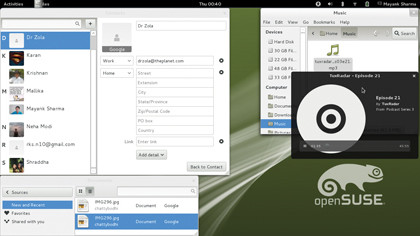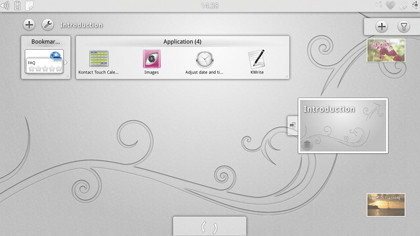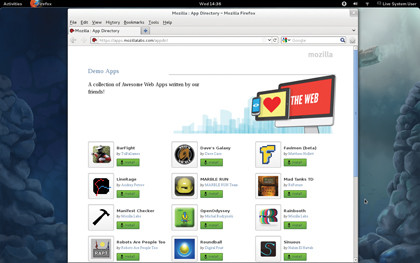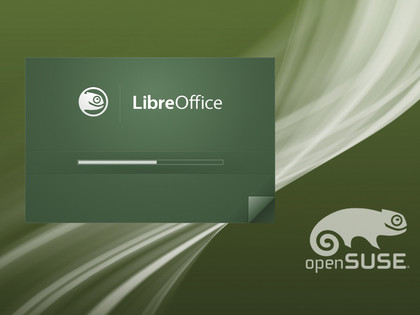Linux in 2012: what to expect
2011 was a big year for Linux but how will 2012 shape up?

For the entire Linux ecosystem in general, and the desktop in particular, last year must have been one of the boldest. Not surprisingly, then, it has stacked up quite a few firsts to its name.
In Gnome 3, and Ubuntu's Unity, it saw two bold attempts at redefining the usability of the Linux desktop. With the first release of Mageia and LibreOffice, it witnessed the triumph of meritocracy and open governance that are so dear to the open-source community, which is still searching for a true open source OS for mobile devices as Intel and the Linux Foundation transition from Meego to Tizen.
In 2011, the Linux kernel celebrated its 20th anniversary with the release of version 3.0. This was the first time in two decades that a major kernel version was released with no major code changes.
But the Linux kernel wasn't the only project that switched to a time-based system and changed its versioning scheme. Mozilla went a step ahead and adopted a rapid release policy for future versions, promising to deliver something new every six weeks.
2011 was also the year when all of the major Linux vendors started focusing on alternate platforms, on multiple devices, and started integrating cloud services into their products. There was a flurry of cross-platform apps that you could run on the desktop as well as on your mobile phone, and cloud-based services that enabled you to keep all of your devices in sync.
All these developments in 2011 have set up a wonderful platform for 2012.
Desktop environments
Gnome
Get daily insight, inspiration and deals in your inbox
Sign up for breaking news, reviews, opinion, top tech deals, and more.

2011 was bitter sweet for Gnome. Its milestone 3.0 release wasn't well received by all of its user base. The developers followed it up with the 3.2 release with improvements to the basic user experience.
According to Allan Day, part of Gnome's design team, there's lots of work going on to refine the core user experience. There are improvements planned for various components of system settings, including the power and sound: "We're also hoping to have some new panels for things like privacy and sharing. The activities overview will also be getting some major changes."
He also hopes that multitouch support will land in the X Server next year so that they can complete their multitouch integration work and roll it out to users.
Gnome 3.2 included a couple of new apps (Contacts and Documents), and you can expect more such apps in future releases: "These were quite early releases, so these two applications will be receiving a lot of work to mature them. We also have other new applications planned, such as Chat, Music, Pictures and Weather."
Day also points to work being done on improving ways of installing apps and updates. "This is one of the newest things that has been happening in Gnome. Some of us in the project have been getting increasingly dissatisfied with the current state of application distribution and installation on Linux. It's hard to know where this will go in the long term, but there is the possibility there of having quicker, easier and safer application installation and software updates."
KDE

Aaron Seigo, KDE Plasma Project leader, is gung-ho about the desktop in the coming year. "2012 is the year that we hit more than just the desktop/laptop form factor, and we're doing so without leaving the desktop behind or crippling our desktop interface." He points to major strides being made in the Nepomuk framework in terms of stability and performance.
Another thing they'll be focusing on is Frameworks 5, which is the modularisation and slimming of KDE's libraries and runtime. "We want to release Frameworks 5 as soon after Qt 5.0 as we can; and Frameworks 5 will give people working on devices, as well as desktop Qt applications, the ability to select the functionality they want from KDE's large array of library features and use just those."
Behind the scenes, KDE has been upstreaming many changes into Qt5 from KDE libraries, including localisation, calendaring, standard path discovery, and more. They're also working on integrating Qt Quick with KDE software.
In terms of releases, Seigo tells us that Plasma Active Two, KDE's desktop for tablets, which was released in December 2011, will be followed by Plasma Active Three in the summer of 2012. "Other major pushes include Calligra, the KDE office suite for both desktop and mobile, as well as delivering great end-user-ready versions of Kontact for the desktop and mobile."
Xfce
The Xfce desktop got a lot of attention from users who weren't satisfied with Gnome 3 or Unity, including Linus Torvalds, who announced switching to the desktop. In 2012, the project will release version 4.10 with several changes.
According to core Xfce developer Jannis Pohlmann, there are several areas of the desktop that are being worked on. He's particularly excited about the Design SIG (Special Interest Group), which looks at improving the usability and visual appearance of the desktop environment.
Two features he's looking forward to are a new AppFinder app, which will merge xfrun4 and the current app finder, and a redesign of the shortcuts pane in Thunar. Also expect tweaks that will improve Xfce's usability on a netbook, such as in the Settings dialogue box.
But, unlike other desktop environments, Xfce will remain focused on the desktop. "I think it's safe to say that in the foreseeable future, Xfce will remain a classic implementation of the desktop metaphor," assures Pohlmann. He expects Xfce 4.10 to be released sometime later in 2012. That release will depend on Gtk+ 2.20, and a major task for the next release will be porting it to Gtk+ 3.0 after the 4.10 release.
App trends

There are too many Linux apps to keep track of all their developments. Also, most apps don't follow a time-based release cycle as most popular distros do; rather their developers release when they think they're ready. So, instead, let's focus on the major factors that will influence the apps you'll be using come 2013.
Most people use only the apps shipped with their distros, or those available in the official repos. This is why most popular desktop distros have special packaging groups, where developers can submit their apps for inclusion.
For example, Ubuntu's Application Review Board is responsible for reviewing and approving applications that will be distributed via the Ubuntu Software Centre. The Fedora Packaging Committee serves a similar purpose for Fedora.
At the recent Ubuntu Developer Summit, the Ubuntu review board decided to revisit the exclusion of the PiTiVi video editor from future Ubuntu releases. They'll also be taking a look at some of the apps packaged with the new Gnome 3.2 release, such as the Sushi file previewer for nautilus, to be included in releases in 2012.
Gnome itself is developing its own set of apps, after introducing a couple with the 3.2 release.
Underlying influence

The changes to the underlying libraries will also influence new apps in 2012. As these libraries evolve to keep pace with the form factors of the multiple devices they run on, so will the apps.
For example, recently the Zeitgeist framework has been ported from Python to Vala. Due to this, it's much streamlined and has a noticeable reduction in startup time, while consuming less resources than before. Since both Gnome and Unity use Zeitgeist, apps released in 2012 based on this newer framework will also be much zippier than before.
The differences between the usability of the various Linux desktop shells hogged all the limelight in 2011. While this distinction isn't going to go away any time soon, the focus seems to be shifting towards the similarities in the apps running on top of them.
If you run both KDE and Gnome apps keep an eye on the Oxygen-Gtk project, which is a port of the default KDE widget theme to Gtk. Its latest avatar supports Gtk 3, which should provide visual consistency between apps based on different toolkits.
Device agnostic Firefox was the first of many apps that were initially designed for the desktop, but are now making their way on to mobile devices. Mozilla has a strong focus on refining its offerings on the mobile platform in 2012. They have several projects lined up to support multitouch gestures, make Firefox for Android compatible with Adobe Flash, and to protect users from malware and phishing attacks.
One of its most talked about services of 2011, Firefox Sync, will also be refined. They are working on polishing the procedure for setting up Firefox Sync across multiple devices. In upcoming versions, Sync will enable you to push tabs between Sync-enabled devices, and also enable syncing of add-ons.
Other traditional app developers are also looking at making their apps work across different devices. At the LibreOffice conference held in Paris in October, developers announced plans to deliver mobile ports of the Office suite for both Android and iOS-based devices. The initial porting effort will focus on the tablet form factor, with phone versions expected later. The last we heard, they hadn't yet started work on the user interface, but are hopeful they'll be able to deliver by late 2012 or early 2013.
Move to the cloud
Also keep an eye out for cloud-based services in 2012 to add to their kitty of features. Canonical is working on the Ubuntu One service to let you sign into an Ubuntu installation using your Ubuntu One cloud credentials. Mandriva Sync, which debuted in Mandriva 2011.0 as a desktop-only service, is also expected to flesh-out to other platforms, with clients expected for both Mac and Windows.
According to Dmitry Komissarov, member of the board at Mandriva SA, you'll also be able to access the service from a client for Android devices in 2012. The current plan is also to take the service from syncing only files and folders and equip it to sync data from within apps, such as address book contacts and browser bookmarks.
KDE's ownCloud is also seeing a lot of activity. Stuart Jarvis, member of the KDE promotion team, informs us of accelerated development in the project in the latter part of 2011, as the service "increasingly becomes a viable solution for all your personal online storage needs".
If you haven't yet heard of it, ownCloud is similar to other web-based services, such as Dropbox and Ubuntu One, in that it enables you to access your files from anywhere on the web, share them securely, stream music, etc. The one major difference is that instead of storing the data on remote servers, it serves it directly from your own machine.
There are various features under development, such as an online text editor, a desktop sync client, a client for Android and more. They'll show up in ownCloud releases throughout 2012.
With almost two decades of writing and reporting on Linux, Mayank Sharma would like everyone to think he’s TechRadar Pro’s expert on the topic. Of course, he’s just as interested in other computing topics, particularly cybersecurity, cloud, containers, and coding.
